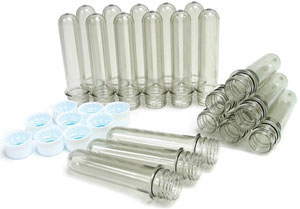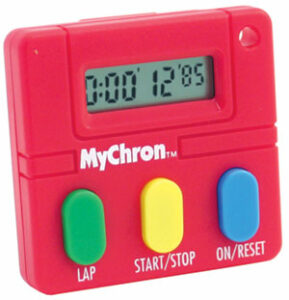 by: Cynthia House
by: Cynthia House
Demonstration Materials:
- 125 ml graduated cylinder or similar item
- ~100 ml of pea gravel or small marbles
- kitchen sponge
- tap water
Experiment Materials:
- preforms and racks (three preforms/student or group)
- fine gravel such as aquarium gravel (~ 30 ml/student or group)
- coarse sand* (~ 30 ml/student or group)
- fine sand* (~ 30 ml/student or group)
- small plastic cups ~ 100 ml capacity
- squares of tulle (“bridal illusion”) and organza, ~ 10 cm x 10 cm
- rubber bands
- electronic balance (capacity at least 100 gm)
- one pound margarine tub or similarly sized plastic cup per balance**
- stopwatch or count-up timer (MyChron Student Timer)
- 125 ml graduated cylinder or similar item
- calculators
- tap water
* Home centers sell sand for sand boxes, landscaping, paving, mortar etc. Beaches are another source, although you may encounter undesirable contamination. Sifting non-homogeneous sand with a fine kitchen strainer may yield two usable grades of sand.
** secondary containment to prevent accidental spillage of water onto the balance
Background Soil Vocabulary:
Porosity is the measure of how much groundwater a soil can hold, permeability is the measure of how quickly water passes through a soil, while retention is the measure of how much water stays behind. Even elementary students can relate these concepts to their everyday lives. They observe that some areas in their yards or school grounds form puddles while others drain quickly after a rainstorm. They may wonder why one neighbor’s garden and yard remains lush and green although a sprinkler is rarely used. Children in communities dependent upon well water can understand the importance of replenishing the water table. In most rural and many suburban areas, homes use septic tanks and drain fields to process household wastewater. The “water cycle” is a topic in elementary science curricula. There are many excellent age-appropriate online sources for information on these topics including the United States Geological Survey (USGS) and the GLOBE program.
The commercially available kits I investigated for porosity/permeability/retention experiments were designed for high school students, requiring a level of dexterity not yet developed in many younger students. They also required much larger quantities of test material. One can expect larger samples to provide more accurate results, however, we achieved acceptable accuracy and precision with the method described here.
Procedure:
Set-up: Using the 125 ml graduated cylinder, measure 25 ml of gravel or sand into each preform tube. 
Prepare one sample of each material for each student or team of students. If you have enough material and preforms, prepare some extra samples in the event a group spoils a test and has time to repeat it. The caps that come with the preforms are particularly useful in that filled tubes need not be stored upright for convenient storage or transport. Provide each student or team of students with their samples placed in racks, one piece of tulle and one piece of damp organza fabric, a small cup, several rubber bands, a timer, pencil, and copies of “Procedure” and “Data Table” sheets.
Demonstration:
Model the procedure by following the instructions on the “Procedure” sheet as the students follow along. Use the 125 ml graduated cylinder in place of a preform tube, and ~100 ml of pea gravel or small marbles. The students will be able to visualize the concepts of “voids” within the sample, and how measuring the water that fills those voids allows one to determine their overall volume. Although it will move very quickly, point out the movement of the waterfront, and when to start and stop the timer. In particular, point out when to stop adding water, and that adding water very slowly is important with the finer materials so as not to overshoot the mark. I believe that overfilling the tube was the cause of most errors.
Students can easily visualize the concept of retention. Let the students handle a dry kitchen sponge. Soak the sponge in a container of water until it is saturated. Wring out the sponge, then allow the students to handle the still-damp sponge.
Experiment:
I allowed the students to proceed at their own pace. I work with first through fifth grade students in a science club; for the purposes of this experiment I paired first and second grade students with older children, primarily because of the reading, and the math involved later on. Adults manned the balances both to speed up the weighing process and to reduce spillage. I used two balances for twelve teams of students; if you have more balances available, and somewhat older students, the students could handle the weighing process themselves. They may need to be taught how to tare the balance using an empty cup.
Analysis:
Students fill in the remaining columns in the data table, rounding porosity and retention values to the nearest five percent. They should calculate permeability to two significant figures. Plot porosity and retention results as histograms, one for each material type. This experiment lends itself to elementary statistical analysis, i.e. mean, mode, and average. I have included histograms from one of my sessions. The presence of a few errant results, both too high and too low, sparked conversation among the students as to possible sources of error in the experiment.
Clean-up:
The sand and gravel can be rinsed out of the preforms, filtered, then spread out on layers of newspaper to dry for reuse.
Cynthia House is the Science Club Adviser at Olive-Mary Stitt Elementary School.

Good project. But in terms of just keeping their interest, this seems like a project maybe better suited for college students who are studying botany or horticulture. Do you find younger kids are able to keep interested in this? I know I would have been bored to death with this at middle school age.
Greetings Portland Landscaping
Thank you for your comment. I do appreciate why you’d question using this activity with elementary school students.
This activity takes about 50 minutes during a single Science club session for first through fifth grade students. I think it is successful for two reasons:
First, we discuss local issues relating to porosity and retention that the kids can easily relate too. Our neighborhood frequently suffers from flooding during heavy rains due to too much paving, over capacity drainage systems and very heavy clay soils. The field and play lot used for recess at the school are often closed due to standing water.
Secondly, this experiment is designed to be fast moving. Samples sizes are small so porosity times are no more than a few minutes, allowing for many trials in a short period of time. Accuracy and precision suffer, but the results are good enough that the kids do discover the relationship between pore size and behavior. The students are divided into groups of three so everyone plays an active role in the testing. ( I wish I could send you one of my favorite Science Club pictures which shows a fourth grade girl with two first grade boys staring intently at their sample, one holding the watch, one pouring the water, and one ready to write down the time.) It’s an easy experiment, so there is little frustration, and they quickly understand what they’re doing and why. We did try, once, to do the experiment with soil collected from the children’s own yards, but the times were simply too slow, not to mention the mess of sticky clay mud.
I agree that I would not be able to hold their interest for an addition Science Club meeting. The next week we do N-P-K testing on soil samples from their yards, look at those soils under magnification etc.